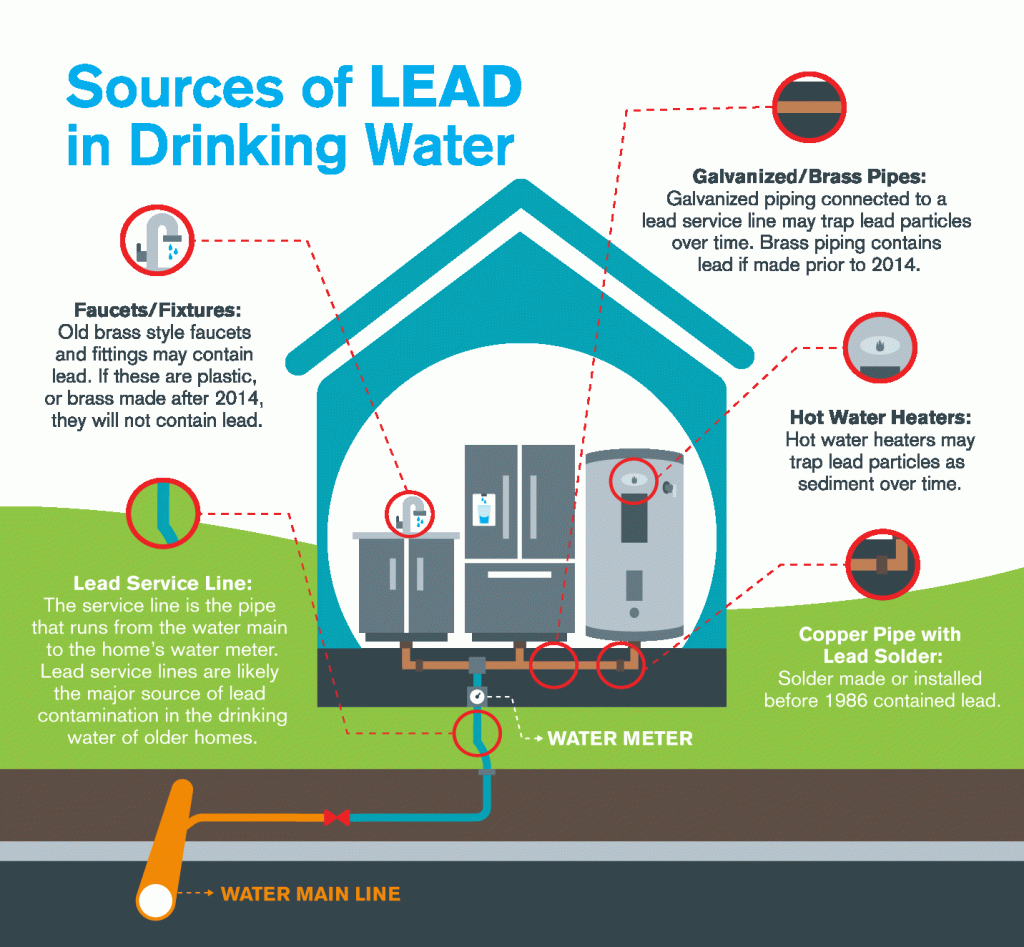LEAD

Common sources of Lead in drinking water are leached from water mains, service lines, in home pipes, faucets, and fixtures. Safe Home offers several kits that provide drinking water testing for lead in city and well water supplies.
Parameter Type: Drinking Water Testing for Volatiles
Parameter Name: Lead
What it is and Where it Comes From:
Lead is a chemical element with the symbol Pb (from the Latin plumbum) and atomic number 82. It is a heavy metal that is denser than most common materials. Lead is soft and malleable, and also has a relatively low melting point. When freshly cut, lead is silvery with a hint of blue; it tarnishes to a dull gray color when exposed to air. Lead has the highest atomic number of any stable element and three of its isotopes are endpoints of major nuclear decay chains of heavier elements. Lead is a neurotoxin and is poisonous to humans and animals when it builds up in bones and tissues. Lead can be found in the soil & atmosphere, which can be naturally occurring or from pollution, can seep into groundwater. Acidic water and water systems that use chloramines to disinfect drinking water can erode pipes and plumbing fixtures which may contain lead. Safe Home offers two platforms of drinking water testing for lead. The first platform in drinking water testing kits for lead is Do-It-Yourself, this allows you to perform testing in the comfort of your own home. The second platform is a Laboratory drinking water testing for lead, allowing you to collect your water sample and ship it directly to our EPA-Certified Laboratory. This platform of drinking water testing for metals will give you an accurate level based on the lowest level of a parameter our instruments can detect (Method Detection Level). Safe Home drinking water testing for lead can be used for city and well water supplies. Drinking water testing should be done any time you notice a significant change in your water quality.
Health Effects:
Lead can cause a variety of adverse health effects when people are exposed to it at high levels for relatively short periods of time. These effects may include interference with red blood cell chemistry, delays in normal physical and mental development in babies and young children, slight deficits in the attention span, hearing, and learning abilities of children, and slight increases in the blood pressure of some adults. Lead has the potential to cause the following effects from a lifetime exposure at high levels: stroke and kidney disease; cancer.
Solutions to Contaminant Levels:
Boiling your water will not remove lead from it. Most systems with thin film composite membranes will reduce lead levels in drinking water, like reverse osmosis, under sink, and most other water purification systems that mirror this process. Reverse Osmosis is A water treatment process that removes undesirable materials from water by using pressure to force the water molecules through a semipermeable membrane. This process is called “reverse” osmosis because the pressure forces the water to flow in the reverse direction (from the concentrated solution to the dilute solution) to the flow direction (from the dilute to the concentrated) in the process of natural osmosis. Many water treatment companies offer both water filtration and reverse osmosis systems, both of which are effective means of providing your family with the clean water. The main difference is in the process of filtration and the type of filtration that is needed for your scenario. Every commercial grade filtration system for the home also reduces lead to below federal guidelines. Known as one of the most effective methods of filtration, the result of a Reverse Osmosis system is the purest, freshest water possible. Who do I need to contact to find out more information about water quality in my area? Every community water supplier must provide an annual report to its customers, known as a Consumer Confidence Report (CCR). The report provides information on your local drinking water quality, including the water’s source, contaminants found in the water, and how consumers can get involved in protecting drinking water. How often does the local public water system preform drinking water testing? Frequency of drinking water testing depends on the number of people served, the type of water source, and types of contaminants. Certain contaminants are tested more frequently than others, as established by the Safe Drinking Water Act. You can find out about levels of regulated contaminants in your treated water for the previous calendar year in your annual Consumer Confidence Report (CCR).


